HTPC - TV Tuner Reviews
by Jarred Walton on December 7, 2005 12:05 AM EST- Posted in
- Smartphones
- Mobile
MyHD MDP-130
The Macro Image Technology (MIT) MyHD MDP-130 has a lot in common with the Fusion5 Gold. It, too, allows the viewing of QAM encoded channels as well as analog TV and OTA DTV broadcasts. You might be interested to know that both the Fusion5 and MyHD originate in Korea, apparently because Korea is one of the few countries that uses similar television standards to the US. Many of the bugs with the Fusion5 - and even MyHD - stem from the fact that Korea has far more strict standards in place for digital TV signals, so there aren't as many special cases that need to be programmed into the software. Besides the features and country of origin, there are quite a few other differences in the cards. Here's a shot of the card before we continue.
It should be immediately clear that this is a much larger card than the Fusion5. The added size comes with added features, so it's a worthwhile upgrade if you can afford it. First, two antenna inputs are supported, so you can connect an OTA DTV antenna as well as a cable connection, or an analog antenna and a digital antenna, or whatever other combination that you might come up with. While there are two inputs, it's important to note that this is not a dual-tuner card - you can't watch one channel and record another, or record two channels simultaneously. (You can't even use the software to watch one recorded broadcast while recording a new broadcast, though that feature appears to be on the wish list for both the Fusion and the MyHD. You can use a second application, but that's not the same thing.)
The major difference between the Fusion and the MyHD is that where the Fusion5 (and many other TV tuners) are predominantly software products for decoding, the MyHD features hardware-based decoding. The benefit of hardware decoding is that processor speed requirements are very reasonable - in fact, a second-hand PC is probably sufficient. The minimum system requirements list a Pentium II 400 MHz with 64MB of RAM. We didn't test in anything anywhere near that outdated, but we can say that CPU usage with our Sempron system remained very low. Even with the overlay window stretched to fill the 1280x720 output (which requires more processing power), CPU usage is well below 20% when watching digital channels. Analog channels are a different story, which we'll get to in a moment.
Like all the other cards in this article, a remote is included with the MyHD along with a USB receiver. The MyHD is the smallest of the remotes, and it also omits many of the extra buttons that are present on the other remotes. Personally, the lack of a "PC Power" button is appreciated. If you want the PC to enter sleep mode or shut down, you can set that as a configuration option, and that's the best way to approach this feature. The only button that I never found useful is the "subchannel" button. If you disable the virtual channel mode, it allows you to switch between sub-channels. I preferred the virtual channel mode.
The rear of the card features a large output connection that attaches to the above cable. Similar to other pass-thru cards in the past, a three-port cable that connects to the video card's VGA port as well as the MyHD card, and the display is provided. (This cable is often jokingly referred to as the "octopus cable".) S-VIDEO and Composite inputs are also an option on a fourth connection, though we didn't use those since we were connected to an HDTV.
Switching to "HD mode" - either by pressing the "HD" button on the remote or by double-clicking the video window - bypasses the graphics card output and uses the output of the MyHD card instead. The software allows you to configure the resolution and type of display used, with most standard resolutions available. (You can find the complete list of supported resolutions at Digital Connections - the specs listed there are actually more accurate than the specs on the MIT site, in case you were wondering.)
The problem with the HD mode is that it only works properly with a VGA display or component connections (a separate VGA-to-component cable is required, but you can get it packaged with the card at many places), but not with a DVI output. If you want to use a DVI port, the solution is to get the additional DVI daughtercard pictured above, the MDP-130DVI. We'd prefer to get everything in one package, and a single slot solution would be nice. However, finding room for both VGA and DVI outputs along with the coaxial connections is almost impossible. A breakout box could suffice, but that would increase costs for all users rather than only those who want to use a DVI port.
Besides VGA or DVI (with daughtercard), there are additional ways of using the MyHD card. As we discussed earlier, ATI cards had a problem with the DVI connection when hooked up to an HDTV. That problem occurs with or without the MDP-130DVI card, making ATI+DVI an unacceptable solution in our view. If you want to get creative, you can try chaining together a few dongles and cables to get the component output of an ATI card to route through the VGA connections of the MyHD "octopus" cable. We didn't try that, and it may not actually work.
If you want something that will work, pick up a transcoder that will convert the VGA RGBHV signal into a component signal. The Audio Authority 9A60 will handle that task, and while it costs more than the DVI daughtercard, it is also more flexible. Feeding the VGA output of the octopus into the transcoder and then using component cables to connect the transcoder to the display will then work.
We tested with both the DVI card as well as the VGA connection going to a PC monitor. For the VGA connection, any standard PC monitor can be used. For someone in a small apartment or college dorm, that might be sufficient, but watching TV on a computer display generally isn't as pleasing as using a larger TV. You can also use the MyHD in dual-display mode, with a standard monitor and either the DVI, VGA, or VGA-to-component cable to connect to a secondary display. If you have a PC near your HDTV, you can even have MyHD showing and/or recording a broadcast while the PC is used for other tasks without difficulty.
The Macro Image Technology (MIT) MyHD MDP-130 has a lot in common with the Fusion5 Gold. It, too, allows the viewing of QAM encoded channels as well as analog TV and OTA DTV broadcasts. You might be interested to know that both the Fusion5 and MyHD originate in Korea, apparently because Korea is one of the few countries that uses similar television standards to the US. Many of the bugs with the Fusion5 - and even MyHD - stem from the fact that Korea has far more strict standards in place for digital TV signals, so there aren't as many special cases that need to be programmed into the software. Besides the features and country of origin, there are quite a few other differences in the cards. Here's a shot of the card before we continue.
It should be immediately clear that this is a much larger card than the Fusion5. The added size comes with added features, so it's a worthwhile upgrade if you can afford it. First, two antenna inputs are supported, so you can connect an OTA DTV antenna as well as a cable connection, or an analog antenna and a digital antenna, or whatever other combination that you might come up with. While there are two inputs, it's important to note that this is not a dual-tuner card - you can't watch one channel and record another, or record two channels simultaneously. (You can't even use the software to watch one recorded broadcast while recording a new broadcast, though that feature appears to be on the wish list for both the Fusion and the MyHD. You can use a second application, but that's not the same thing.)
The major difference between the Fusion and the MyHD is that where the Fusion5 (and many other TV tuners) are predominantly software products for decoding, the MyHD features hardware-based decoding. The benefit of hardware decoding is that processor speed requirements are very reasonable - in fact, a second-hand PC is probably sufficient. The minimum system requirements list a Pentium II 400 MHz with 64MB of RAM. We didn't test in anything anywhere near that outdated, but we can say that CPU usage with our Sempron system remained very low. Even with the overlay window stretched to fill the 1280x720 output (which requires more processing power), CPU usage is well below 20% when watching digital channels. Analog channels are a different story, which we'll get to in a moment.
 |
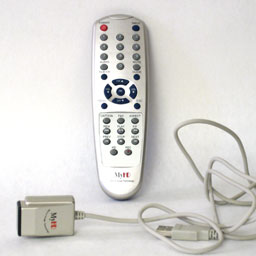 |
| Click to enlarge. | |
Like all the other cards in this article, a remote is included with the MyHD along with a USB receiver. The MyHD is the smallest of the remotes, and it also omits many of the extra buttons that are present on the other remotes. Personally, the lack of a "PC Power" button is appreciated. If you want the PC to enter sleep mode or shut down, you can set that as a configuration option, and that's the best way to approach this feature. The only button that I never found useful is the "subchannel" button. If you disable the virtual channel mode, it allows you to switch between sub-channels. I preferred the virtual channel mode.
The rear of the card features a large output connection that attaches to the above cable. Similar to other pass-thru cards in the past, a three-port cable that connects to the video card's VGA port as well as the MyHD card, and the display is provided. (This cable is often jokingly referred to as the "octopus cable".) S-VIDEO and Composite inputs are also an option on a fourth connection, though we didn't use those since we were connected to an HDTV.
Switching to "HD mode" - either by pressing the "HD" button on the remote or by double-clicking the video window - bypasses the graphics card output and uses the output of the MyHD card instead. The software allows you to configure the resolution and type of display used, with most standard resolutions available. (You can find the complete list of supported resolutions at Digital Connections - the specs listed there are actually more accurate than the specs on the MIT site, in case you were wondering.)
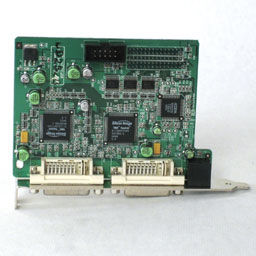 |
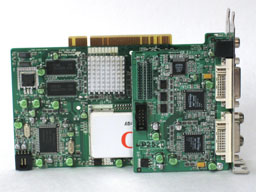 |
| Click to enlarge. | |
The problem with the HD mode is that it only works properly with a VGA display or component connections (a separate VGA-to-component cable is required, but you can get it packaged with the card at many places), but not with a DVI output. If you want to use a DVI port, the solution is to get the additional DVI daughtercard pictured above, the MDP-130DVI. We'd prefer to get everything in one package, and a single slot solution would be nice. However, finding room for both VGA and DVI outputs along with the coaxial connections is almost impossible. A breakout box could suffice, but that would increase costs for all users rather than only those who want to use a DVI port.
Besides VGA or DVI (with daughtercard), there are additional ways of using the MyHD card. As we discussed earlier, ATI cards had a problem with the DVI connection when hooked up to an HDTV. That problem occurs with or without the MDP-130DVI card, making ATI+DVI an unacceptable solution in our view. If you want to get creative, you can try chaining together a few dongles and cables to get the component output of an ATI card to route through the VGA connections of the MyHD "octopus" cable. We didn't try that, and it may not actually work.
If you want something that will work, pick up a transcoder that will convert the VGA RGBHV signal into a component signal. The Audio Authority 9A60 will handle that task, and while it costs more than the DVI daughtercard, it is also more flexible. Feeding the VGA output of the octopus into the transcoder and then using component cables to connect the transcoder to the display will then work.
We tested with both the DVI card as well as the VGA connection going to a PC monitor. For the VGA connection, any standard PC monitor can be used. For someone in a small apartment or college dorm, that might be sufficient, but watching TV on a computer display generally isn't as pleasing as using a larger TV. You can also use the MyHD in dual-display mode, with a standard monitor and either the DVI, VGA, or VGA-to-component cable to connect to a secondary display. If you have a PC near your HDTV, you can even have MyHD showing and/or recording a broadcast while the PC is used for other tasks without difficulty.


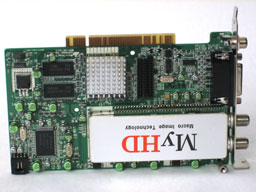

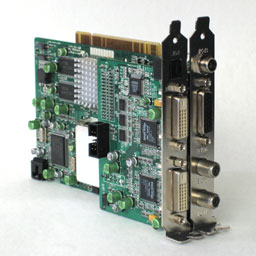
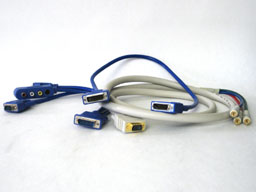








77 Comments
View All Comments
Brian23 - Thursday, December 8, 2005 - link
I'm supprised more people aren't talking about this. I haven't downloaded them, but I assume they are recordings of OTA broadcasts. If that's the case, then I'm suprised Anandtech posted them. In the news section they're always posting stuff about how people are getting sued for sharing movies. Most of the movies out there on torrents have been broadcast OTA at some point which would make them public domain. Everyone is so quick to judge someone when they post a torrent of something, but mysteriously no-one has said anything about this yet.JarredWalton - Thursday, December 8, 2005 - link
They're basically 30 second clips demonstrating analog/HDTV videos. If anyone wants to come after me for posting sample content... wow, they have way too much time on their hands. I guess I didn't bother to get "express, written consent" though....Brian23 - Thursday, December 8, 2005 - link
I don't fault you for posting this, and I don't think you need express written consent. I think the whole lawsuit thing over p2p file sharing is a bunch of crap. My point I was trying to make in my previous post was that I was suprised that no-one was was posting anything about copywrite violations. Normally the people here at Anandtech scream and yell if there's something being distributed that's copywritten, no matter what it is. I think people should be able to share stuff that they recorded from OTA.valnar - Wednesday, December 7, 2005 - link
Perhaps I missed something in the review, but what's the point of posting screen shot comparisons of a transport stream? They would all be identical across all the cards, unless there were bit errors in the stream. Of course they all look good! They should also look the same too. The only way to show a difference would be through a video card, such as a particular ATI or nVidia in either overlay or VMR9 mode. Or with the hardware output of the MyHD series of cards, which is vastly superior to the software based cards. If you have an HDTV and have used the DVI or Component out of the MDP-1xx, they are fantastic. Of course, a screenshot wouldn't show that. Maybe a digital photo or something(?).It should also be noted that watching HDTV on overlay is a big no-no. The overlay was never meant to register more than 540 lines of resolution. While deciding between overlay or VMR9 for DVD (740x480/NTSC) watching is a matter of religious debate, overlay can never resolve HD properly. I would submit that the reviewer possibly didn't see any of those cards in their full glory.
-Robert
xtknight - Wednesday, December 7, 2005 - link
Where is this overlay limitation stated and what happens when you go above said lines? I'm sorry but I find that hard to believe. SIL overlay vs. SIL VMR9 looks the exact same to me as I remember it. What does 540 lines mean? What resolution is the max (x by y)?JarredWalton - Wednesday, December 7, 2005 - link
I'm a little confused by this overlay limitation as well. I mean, obviously the Fusion5 only works through overlay, but the video stream is transferred digitally from the TV Tuner to the graphics card. There should be no limitation other than bandwidth, I thought? Maybe I'm using the term "overlay" incorrectly here?As for the HD images, I mentioned that they are all identical for TP captures. They were included to show people exactly how much data HDTV contains (and how much better looking HDTV is) relative to analog/SDTV. The upsampled SDTV image is also there to show how poor that looks in comparison to a real HDTV stream - and I get far too much upsampled content on most HD channels.
valnar - Thursday, December 8, 2005 - link
These limits are discussed in all the usual forums, like avsforum.com.JarredWalton - Thursday, December 8, 2005 - link
Link please? I just don't see how the hardware overlay interface on your video card could possibly be limited to only 720 x 480. Windows Media Player uses the overlay mode for playing video. Last I checked, it's fully capable of playing 1080I resolution. NTSC signals have nothing to do with overlay mode inside computers.valnar - Thursday, December 8, 2005 - link
It not limited per se, but you won't see much of an improvement at a rez above 540 lines horizontal. Everything (like WMP) can use the Overlay, but if you were to truly show a video in 1080P mode, for example, it wouldn't be as sharp - because of most video card overlay limitations. It's hard to explain, as the resolution of overlay is more an "analog" style of limitation, to use that metaphor inaccurately. It simply doesn't resolve the detail of HDTV, period. Get a 100" screen and a projector and it becomes obvious. Forgive me for not being able to articulate it, hence my recommendation to visit Home Theater/HTPC specific forums.xtknight - Thursday, December 8, 2005 - link
I can't find anything about this limitation with google or avsforum search. Are you mixing up overlay with interlacing? It would be nice if you could provide us with a link because we effectively have no clue what you're talking about here...